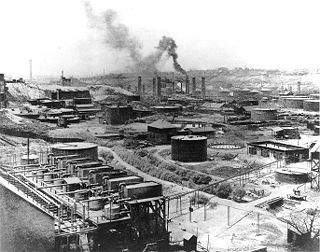Related Research Articles

The Sherman Antitrust Act of 1890 is a United States antitrust law which prescribes the rule of free competition among those engaged in commerce. It was passed by Congress and is named for Senator John Sherman, its principal author.

The Clayton Antitrust Act of 1914, is a part of United States antitrust law with the goal of adding further substance to the U.S. antitrust law regime; the Clayton Act seeks to prevent anticompetitive practices in their incipiency. That regime started with the Sherman Antitrust Act of 1890, the first Federal law outlawing practices that were harmful to consumers. The Clayton Act specified particular prohibited conduct, the three-level enforcement scheme, the exemptions, and the remedial measures.

In the United States, antitrust law is a collection of mostly federal laws that regulate the conduct and organization of businesses to promote competition and prevent unjustified monopolies. The three main U.S. antitrust statutes are the Sherman Act of 1890, the Clayton Act of 1914, and the Federal Trade Commission Act of 1914. These acts serve three major functions. First, Section 1 of the Sherman Act prohibits price fixing and the operation of cartels, and prohibits other collusive practices that unreasonably restrain trade. Second, Section 7 of the Clayton Act restricts the mergers and acquisitions of organizations that may substantially lessen competition or tend to create a monopoly. Third, Section 2 of the Sherman Act prohibits monopolization.

Robert Heron Bork was an American legal scholar who served as solicitor general of the United States from 1973 until 1977. A professor by training, he was acting United States Attorney General and a judge on the U.S. Court of Appeals for the D.C. Circuit from 1982 to 1988. In 1987, President Ronald Reagan nominated Bork to the U.S. Supreme Court, but the Senate rejected his nomination after a contentious and highly publicized confirmation hearing.
Predatory pricing is a commercial pricing strategy which involves the use of large scale undercutting to eliminate competition. This is where an industry dominant firm with sizable market power will deliberately reduce the prices of a product or service to loss-making levels to attract all consumers and create a monopoly. For a period of time, the prices are set unrealistically low to ensure competitors are unable to effectively compete with the dominant firm without making substantial loss. The aim is to force existing or potential competitors within the industry to abandon the market so that the dominant firm may establish a stronger market position and create further barriers to entry. Once competition has been driven from the market, consumers are forced into a monopolistic market where the dominant firm can safely increase prices to recoup its losses.
The rule of reason is a legal doctrine used to interpret the Sherman Antitrust Act, one of the cornerstones of United States antitrust law. While some actions like price-fixing are considered illegal per se, other actions, such as possession of a monopoly, must be analyzed under the rule of reason and are only considered illegal when their effect is to unreasonablyrestrain trade. William Howard Taft, then Chief Judge of the Sixth Circuit Court of Appeals, first developed the doctrine in a ruling on Addyston Pipe and Steel Co. v. United States, which was affirmed in 1899 by the Supreme Court. The doctrine also played a major role in the 1911 Supreme Court case Standard Oil Company of New Jersey v. United States.
Competition law is the field of law that promotes or seeks to maintain market competition by regulating anti-competitive conduct by companies. Competition law is implemented through public and private enforcement. It is also known as antitrust law, anti-monopoly law, and trade practices law; the act of pushing for antitrust measures or attacking monopolistic companies is commonly known as trust busting.
Resale price maintenance (RPM) or, occasionally, retail price maintenance is the practice whereby a manufacturer and its distributors agree that the distributors will sell the manufacturer's product at certain prices, at or above a price floor or at or below a price ceiling. If a reseller refuses to maintain prices, either openly or covertly, the manufacturer may stop doing business with it. Resale price maintenance is illegal in many jurisdictions.
United States v. Trans-Missouri Freight Association, 166 U.S. 290 (1897), was a United States Supreme Court case holding that the Sherman Act applied to the railroad industry, even though the U.S. Congress had enacted a comprehensive regime of regulations for that industry.
In United States antitrust law, monopolization is illegal monopoly behavior. The main categories of prohibited behavior include exclusive dealing, price discrimination, refusing to supply an essential facility, product tying and predatory pricing. Monopolization is a federal crime under Section 2 of the Sherman Antitrust Act of 1890. It has a specific legal meaning, which is parallel to the "abuse" of a dominant position in EU competition law, under TFEU article 102. It is also illegal in Australia under the Competition and Consumer Act 2010 (CCA). Section 2 of the Sherman Act states that any person "who shall monopolize. .. any part of the trade or commerce among the several states, or with foreign nations shall be deemed guilty of a felony." Section 2 also forbids "attempts to monopolize" and "conspiracies to monopolize". Generally this means that corporations may not act in ways that have been identified as contrary to precedent cases.
Leegin Creative Leather Products, Inc. v. PSKS, Inc., 551 U.S. 877 (2007), is a US antitrust case in which the United States Supreme Court overruled Dr. Miles Medical Co. v. John D. Park & Sons Co.Dr Miles had ruled that vertical price restraints were illegal per se under Section 1 of the Sherman Antitrust Act. Leegin established that the legality of such restraints are to be judged based on the rule of reason.
Competition law theory covers the strands of thought relating to competition law or antitrust policy.
The Parker immunity doctrine is an exemption from liability for engaging in antitrust violations. It applies to the state when it exercises legislative authority in creating a regulation with anticompetitive effects, and to private actors when they act at the direction of the state after it has done so. The doctrine is named for the Supreme Court of the United States case in which it was initially developed, Parker v. Brown.
NCAA v. Board of Regents of the University of Oklahoma, 468 U.S. 85 (1984), was a case in which the Supreme Court of the United States held that the National Collegiate Athletic Association (NCAA) television plan violated the Sherman and Clayton Antitrust Acts, which were designed to prohibit group actions that restrained open competition and trade.
Continental Television v. GTE Sylvania, 433 U.S. 36 (1977), was an antitrust decision of the Supreme Court of the United States. It widened the scope of the "rule of reason" to exclude the jurisdiction of antitrust laws.
Aspen Skiing Co. v. Aspen Highlands Skiing Corp., 472 U.S. 585 (1985), was a United States Supreme Court case that decided whether a dominant firm's unilateral refusal to deal with a competitor could establish a monopolization claim under Section 2 of the Sherman Act. The unanimous Supreme Court agreed with the 10th Circuit that terminating a pro-consumer joint venture without a legitimate business justification could constitute illegal monopolization. However, its decision created an exception to the general rule that firms can decide with whom to do business absent collusion, sparking significant controversy about the appropriate scope of this exception. In a subsequent case, Verizon Communications Inc. v. Law Offices of Curtis V. Trinko, LLP, Justice Scalia, writing for the majority, stated that Aspen Skiing is "at or near the outer boundary of § 2 liability." Although its holding has been narrowed, this case's relevance remains contested, especially in the context of refusals to license intellectual property.
Donald Frank Turner was an American antitrust attorney, economist, legal scholar and educator who spent most of his career teaching at Harvard Law School. He was also Assistant Attorney General in charge of the Antitrust Division from 1965 to 1968.
Pfizer Inc. v. Government of India, 434 U.S. 308 (1978), decision of the Supreme Court of the United States in which the Court held that foreign states are entitled to sue for treble damages in U.S. courts, and should be recognized as "persons" under the Clayton Act.

The history of United States antitrust law is generally taken to begin with the Sherman Antitrust Act 1890, although some form of policy to regulate competition in the market economy has existed throughout the common law's history. Although "trust" had a technical legal meaning, the word was commonly used to denote big business, especially a large, growing manufacturing conglomerate of the sort that suddenly emerged in great numbers in the 1880s and 1890s. The Interstate Commerce Act of 1887 began a shift towards federal rather than state regulation of big business. It was followed by the Sherman Antitrust Act of 1890, the Clayton Antitrust Act and the Federal Trade Commission Act of 1914, the Robinson-Patman Act of 1936, and the Celler-Kefauver Act of 1950.
In the context of U.S. competition law, the consumer welfare standard (CWS) or consumer welfare principle (CWP) is a legal doctrine used to determine the applicability of antitrust enforcement.
References
- 1 2 Blair, Roger D.; Sokol, Daniel D (2012). "The Rule of Reason and the Goals of Antitrust: An Economic Approach". Antitrust Law Journal. 78 (2).
- ↑ Priest GL. (2008). The Abiding Influence of the Antitrust Paradox. Harvard Journal of Law & Public Policy.
- ↑ Bork (1978) p.405.
- ↑ Bork (1978) p.66.
- 1 2 Orbach, Barak (2011). "The Antitrust Consumer Welfare Paradox". 7 Journal of Competition Law & Economics. No. 133. SSRN 1553226.